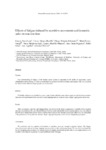Mostrar o rexistro simple do ítem
Effects of Fatigue Induced by Repetitive Movements and Isometric Tasks on Reaction Time
| dc.contributor.author | Soto-León, Vanesa | |
| dc.contributor.author | Alonso-Bonilla, Carlos | |
| dc.contributor.author | Peinado-Palomino, Diego | |
| dc.contributor.author | Torres-Pareja, Marta | |
| dc.contributor.author | Mendoza-Laiz, Nuria | |
| dc.contributor.author | Mordillo-Mateos, Laura | |
| dc.contributor.author | Onate-Figuerez, Ana | |
| dc.contributor.author | Arias, Pablo | |
| dc.contributor.author | Aguilar, Juan | |
| dc.contributor.author | Oliviero, Antonio | |
| dc.date.accessioned | 2020-10-27T09:16:49Z | |
| dc.date.issued | 2020-09-25 | |
| dc.identifier.citation | Soto-Leon V, Alonso-Bonilla C, Peinado-Palomino D, et al. Effects of fatigue induced by repetitive movements and isometric tasks on reaction time. Hum Mov Sci. 2020; 73:102679 | es_ES |
| dc.identifier.issn | 0167-9457 | |
| dc.identifier.issn | 1872-7646 | |
| dc.identifier.uri | http://hdl.handle.net/2183/26545 | |
| dc.description.abstract | [Abstract] Purpose: The understanding of fatigue of the human motor system is important in the fields of ergonomics, sport, rehabilitation and neurology. In order to understand the interactions between fatigue and reaction time, we evaluated the effects of two different fatiguing tasks on reaction time. Methods: 83 healthy subjects were included in a case-control study with three arms where single and double choice reaction time tasks were performed before and after 2 min fatiguing task (an isometric task, a finger tapping task and at rest). Results: After an isometric task, the right-fatigued hand was slower in the choice component of a double choice reaction time task (calculated as the individual difference between single and double choice reaction times); also, the subjects that felt more fatigued had slower choice reaction time respect to the baseline assessment. Moreover, in relationship to the performance decay after two minutes, finger tapping task produces more intense fatigability perception. Conclusions: We confirmed that two minutes of isometric or repetitive tasks are enough to produce fatigue. The fatigue perception is more intense for finger tapping tasks in relation to the performance decay. We therefore confirmed that the two fatiguing tasks produced two different kind of fatigue demonstrating that with a very simple protocol it is possible to test subjects or patients to quantify different form of fatigue. | es_ES |
| dc.description.sponsorship | Ministerio de Economía y Competitividad; SAF2016-80647-R | es_ES |
| dc.language.iso | eng | es_ES |
| dc.publisher | Elsevier | es_ES |
| dc.relation.uri | https://doi.org/10.1016/j.humov.2020.102679 | es_ES |
| dc.subject | Fatigue | es_ES |
| dc.subject | Repetitive movements | es_ES |
| dc.subject | Isometric contractions | es_ES |
| dc.subject | Human | es_ES |
| dc.subject | Reaction time | es_ES |
| dc.title | Effects of Fatigue Induced by Repetitive Movements and Isometric Tasks on Reaction Time | es_ES |
| dc.type | info:eu-repo/semantics/article | es_ES |
| dc.rights.access | info:eu-repo/semantics/embargoedAccess | es_ES |
| dc.date.embargoEndDate | 2022-09-25 | es_ES |
| dc.date.embargoLift | 2022-09-25 | |
| UDC.journalTitle | Human Movement Science | es_ES |
| UDC.volume | 73 | es_ES |
| UDC.startPage | 102679 | es_ES |
Ficheiros no ítem
Este ítem aparece na(s) seguinte(s) colección(s)
-
GI-NEURO - Artigos [132]
-
INIBIC-NEURO - Artigos [48]






